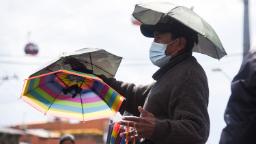
Ranges of UV radiation have at instances in current weeks hit 21 on a scale that usually solely goes up so far as 20. In line with the World Well being Group, a UV index of 11 is considered “excessive,” with individuals cautioned to keep away from publicity to the solar.
“The solar is burning. This solar is not regular,” mentioned La Paz resident Segundina Mamani, as individuals within the metropolis at 3,600 meters (11,800 toes) above sea stage tried to maintain cool by consuming shaved ice and conserving to the shadows.
The high-altitude Andean areas of South America may be hit by among the most harmful ranges of UV radiation on the earth, with numbers which have at instances reached report heights of above 40 on the index. However a quantity between 11 and 17 is extra typical.
“This is a matter that has actually had La Paz cooking,” mentioned Juan Pablo Palma, a threat administration official with the municipal authorities.
With world leaders assembly in Glasgow for the COP26 local weather convention amid warnings that the local weather mild is flashing purple, some Bolivian scientists mentioned altering rainfall patterns have been sharpening the consequences of UV radiation by decreasing cloud cowl.
“We now have confirmed what many say: the wet season can convey the identical quantity of rain but it surely’s shorter,” mentioned Luis Blacutt, a researcher on the atmospheric physics laboratory in La Paz, who has made local weather change fashions to check the development.
Whereas some rains introduced reduction this week, the laboratory expects the excessive UV ranges to final a minimum of for an additional week.
“That implies that the event of clouds is delayed, the enter of ultraviolet radiation is extra noticeable… Now that there are not any clouds, we now have an entry of a considerable amount of ultraviolet radiation that impacts everybody,” mentioned Blacutt.


